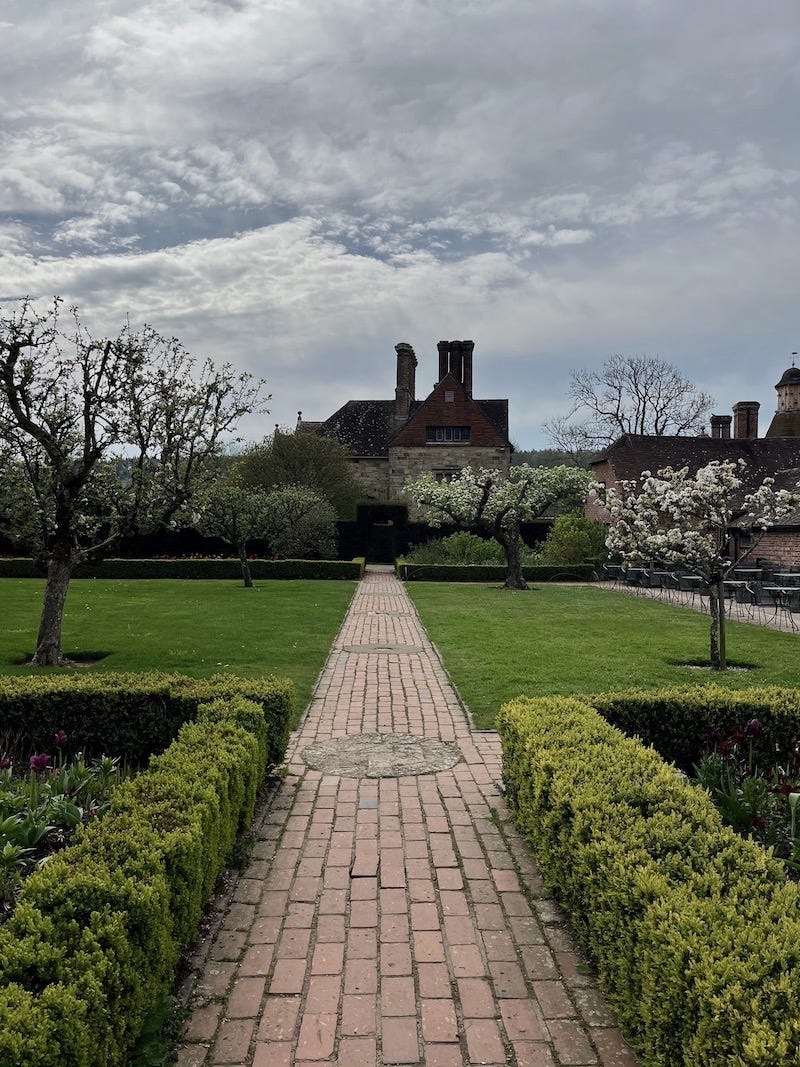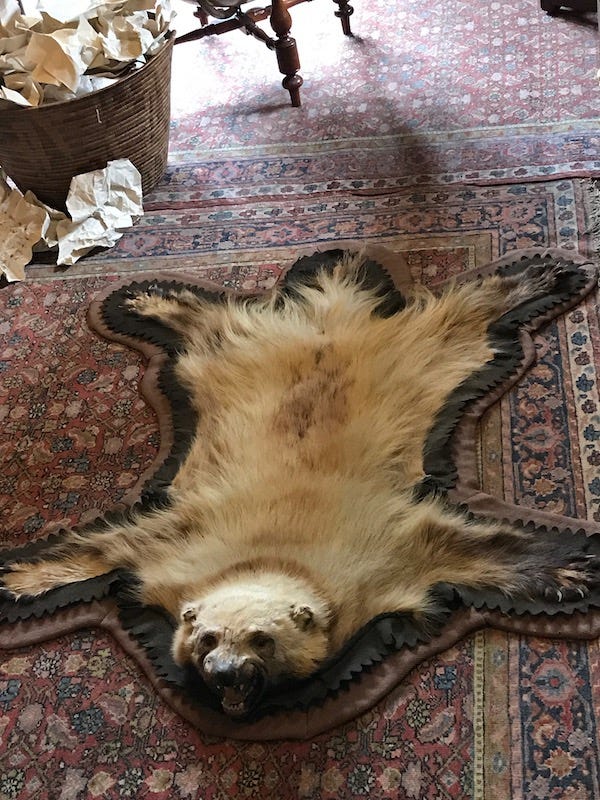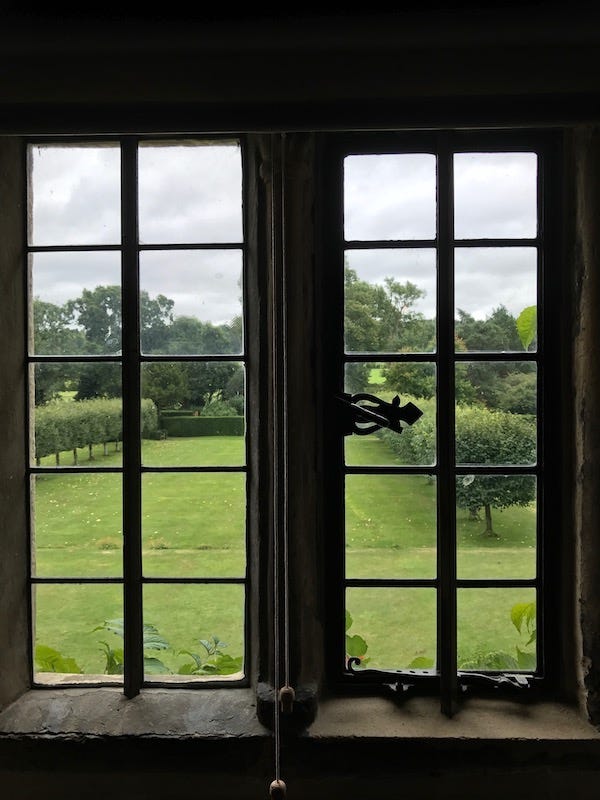We arrive at Batemans, the former home of Rudyard Kipling, via “an enlarged rabbit hole of a lane” (his words, not mine, but I do agree). The home and extensive gardens are secreted in the wooded landscape of the Sussex Weald, affording privacy writers dream of.
It is love at first sight for me as it was for Kipling, the prospective owner responding to his first viewing of Bateman's:
'That's She! The Only She! Make an honest woman of her - quick!'
A sloping red-brick path draws us from the National Trust car park down through the orchard.
Apple and pear trees, in full blossom, rise out of perfectly cut circles in perfectly manicured lawn, surrounded by perfectly clipped box hedges that restrain the rambling cottage garden.
A mighty row of six diamond-shaped red-brick chimney stacks stands tall atop the roof of the impressive 17th-century Jacobean house.
We are guided towards the house through a high hedge opening, along the crazy-stone path to the northeast facing the original entrance of the mansion, pausing to admire guests' original approach.
Wisteria, roses and ivy clasp, climb and clamber, vying for space on the weathered but warming, yellow sandstone walls. South-facing Wisteria patiently waits for sunnier days to bloom. Pink anemones pop out of the fernery at ground level. What a joy to watch Spring unfolding.
An open front door, light from mullioned windows and slightly-ajar attic windows suggest someone is home.
We adjust our eyes as we enter the house. Dark, sombre oak beams, dark wood panelling, and dark curtains transport us back to a grand Edwardian era.
Head up the carpeted wooden staircase; take a right-turn to the main event, Kipling's study. It's clear this is the heart of the house, a sanctuary.
Dark oak bookshelves cover all four walls. Shelves are filled to the brim with volumes of red, blue and green bound books edged with gold. Other minor volumes fill any gaps. Memorabilia and Oriental travel mementos dot the shelves. Well-read and well-travelled, Mr Kipling looks down from his dark-framed photograph on the top shelf.
Thin red patterned carpet covers a wooden floor, attempting to retain some of the heat generated by the fireplace. A bearskin rug eyes visitors from its flattened perspective.
A smaller desk, typewriter ready, sits under the south-facing window illuminating the space, infusing it with English green. A leather satchel sits against its chair leg.
The main desk, scattered with books and correspondence, sits in the centre of the room, looking towards the northeast view.
A world globe sits under the desk, in its four-legged stand, and a spare globe sits on a small table to the left of it, just in case the first one is incorrect.
A waste bin at the author's right hand is overflowing with scrumpled paper. I pause to appreciate our 21st-century tree-saving technology.
Two empty chairs at this desk sit in conversation mode. The author and his visitor have stepped out for a brisk walk through the terraced lawn garden to continue their discussion.
The only missing detail is the pungent aroma of Kipling's forty-a-day Turkish cigarette habit.
Whether he is here or not, his spirit is alive. Romance and a sense of history are infused into every book, piece of paper or item of furniture.
Kipling was an influential writer. He had a unique ability to capture the essence of British India and bring it to life through his writing. His vivid descriptions of India's people, places, and cultures and his portrayal of the British Raj during that time period have been praised for accuracy and authenticity.
Additionally, Kipling's writing explored important 19th and early 20th-century themes, such as imperialism, colonialism, and social inequality, often dealing with complex moral and ethical issues. His characters were often human and deeply flawed, making them relatable to readers.
Finally, Kipling's writing style was unique and innovative for its time. He was a master of the short story and the poem, and his use of language and imagery was unparalleled in his day.
However, what captures my attention, apart from that moustache, is his prolificacy. His legacy is a substantial and diverse body of work that still engages readers, even if now somewhat controversial.
As a relatively new writer, I want to know how to write prolifically. Unfortunately, I didn't do a Literature or a Journalism degree requiring me to write and write until my hands ached as I improved my prose quality.
Similarly, Kipling wasn’t privy to university education. However, he apprenticed to two Indian newspapers, referring to the first as his "mistress and most true love". Stephen Wheeler, the editor of the Civil and Military Gazette in Lahore, worked Kipling hard but commented that Kipling's need to write was unstoppable.
At the other end of the spectrum, my weekly Substack pieces are birthed with long and painful labour pains.
I need to write faster. I need to write smarter without assistance from a demanding editor or the deadline of a university assignment or exam.
I put on my researcher hat and head down the Amazon rabbit hole. I want to learn to write with more flow. I come across an interesting Amazon title. Aren't they all?
5,000 Words per Hour - Write Faster, Write Smarter by Chris Fox.
I like the sound of it.
The book is designed around novel writing, but it can be applied to any writing.
The gist of it is a writing habit but with a twist.
You do all the habit stuff - pick a set time to write, lock out distractions, and create a plan for the writing session, generally a novel scene. Then, set the clock and write. Don't stop, look back etc., until the bell goes. So far, so good. But here's the twist.
The word count goes onto a spreadsheet. Now you're talking, and I am all ears. I am a tracker; I've been a tracker forever. I'm very good at tracking and streaks. I have some mighty big ones.
So, I write to a daily prompt for 10 mins working up to 30 minutes over time. Then I enter the date, time and number of words onto my spreadsheet. That takes care of the habit and forces me to confront regular writing and word counts.
Then I work on increasing the number of words and writing quality. It's like building muscle using my Peloton strength training - increase reps, add heavier weights. To build on this foundational writing habit, I can add resources like 100 Ways to Improve Your Writing to add quality. Genius.
I can hear all you wonderful writers out there going - duh!, but this accounting/finance/numbers geek missed Writing 101. I have now found a structured way to get traction, develop writing fluency and quality, and let go of perfection.
I may even turn my hand to fiction writing, something I could never have imagined.
While Substack will always be populated with engaging journalists and quality writers, it's also opening to new writers looking for the confidence to join the conversation. Hope this helps.
My favourite reads this week:
Substack and the Writing Long-Game by Rae Katz
I just want us to be good to each other by Antonia Malchik
Why did medieval people invent so many collective nouns? by Weird Medieval Guys










I had a similar experience last year at one of Wordsworth's homes in the Lake District. It inspired me to write poetry again...at least, for a few weeks! 🤣